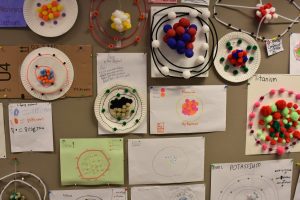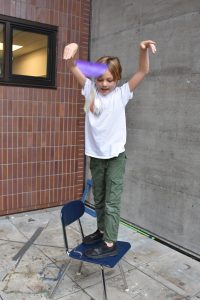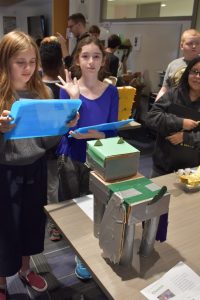Scientific Skills
Gaynor’s science curriculum prepares students for high school and beyond
A hallmark of Gaynor’s educational philosophy is creating opportunities for students to follow their passions. The school’s Science Department is dedicated to fostering students’ interests in the sciences from an early age, and to preparing students for future academic work in science.
Students at Gaynor begin dedicated science classes in the Pink Cluster, the first cluster in the Lower School, and by the time they reach the Blue Cluster, they are taking science classes four times per week. Students will gain experience in earth science, chemistry, biology, and physics by the time they graduate from the Blue Cluster. While each of those subject areas is important, the faculty in the Science Department are focused primarily on providing students with the skills and abilities they will need to continue through high school and beyond.
In Teaching Secondary School Science: Strategies for Developing Scientific Literacy (R.W. Bybee, J.C. Powell, L.W. Trowbridge, 2008 edition, p. 230-231), the authors detail the categories of skills that students should acquire through the study of science in middle and high school: acquisitive, organizational, creative, manipulative, and communicative.
We sat down with Science Department Chair Christina Fabricant to understand how Gaynor is preparing students in these five areas.
Acquisitive
Observing, researching, investigating, and gathering information

Ms. Fabricant described a recent long-term project undertaken by her students in the Blue Cluster. “We had each student research a specific element on the periodic table. The students needed to find valid resources that provided sufficient information on the element they chose. During the project, I reinforced the idea that some sources are more valid than others, and that Wikipedia should be used with caution,” explained Fabricant. Once the students had gathered and synthesized their research, they created three-dimensional models of their chosen element. In addition to being a multisensory way to learn about their element, “it was a way for me to assess their understanding of atomic structure by using the information that they researched on their element and applying it to their understanding of what an atom looks like.”
Organizational
Putting information in a systematic order

Many students with learning differences find this set of skills to be a particular challenge. Students at Gaynor are taught organizational skills in a highly scaffolded way. According to Ms. Fabricant, “Some students may be beginning to learn how to make tables and charts, using applications in the Google Suite to help organize data in a meaningful way.” She continued, “Some students who have already acquired those skills are progressing further, learning how to take the data they have collected and represent it in multiple ways using graphs of many types.”
This fall, in Jacqueline Smith’s Yellow Cluster classes, students gathered data on different aspects of parachutes. The students used the steps associated with the design cycle (investigate, design, create, evaluate) in order to build a perfect parachute. They conducted a large-scale investigation in which they changed different parts of a parachute to see which parameters worked best for a slow and safe landing. They explored variables such as canopy shape and size, as well as load composition. All of this investigating led to their ultimate “Egg Drop Challenge.” They built their version of a perfect parachute based on the data they collected and analyzed throughout the investigatory labs. According to Ms. Smith, “By the time they were ready to build, they had engaged with the design cycle multiple times. Systematically organizing information is built into the unit.”
Creative
How to develop new approaches and new ways of thinking
In Lindsey Marx’s Red Cluster classes, students were inspired toward scientific creativity after seeing the massive pumpkin brought back from the Apple Picking trip in September. They saw how it took several of the school’s maintenance staff members to lift what turned out to be a 130-pound pumpkin. Ms. Marx challenged the students to find a scientific solution to moving the pumpkin safely and easily. The students worked to create designs for inclined planes, exploring different types of surfaces and steepness levels, and then used the information they gathered to design the perfect tool. They created small-scale models, and presented their proposed designs to Dr. Gaynor. Perhaps next year’s pumpkin moving will be a bit easier thanks to these creative Red Cluster students.
Manipulative
Handling materials and scientific instruments
In Middle School, students are introduced to a variety of scientific tools, and learn about lab safety. One of the most advanced instruments Gaynor students learn to use is a compound microscope. This spring, students in Andrew Presarn’s Green Cluster classes will be introduced to microscopes and learn how to safely use and care for them. Once they have experience with manipulating the microscope, they will use it to look at samples of human organs to better understand cellular structure in the human body. Experience and fluency with using different types of scientific tools is important preparation for future scientific study.
Communicative
Transferring and explaining information correctly from one experimenter to another

As they move through the science curriculum, Gaynor students gain experience with the format and practice of writing lab reports. However, written lab reports are not the only way in which young scientists can present their findings. Students in Mollianne Grady’s Gold Cluster classes used the green screen in the SMART Lab to produce videos in which the students described newly-invented animals and explained how those animals were well adapted to their environments. The students really enjoyed this hands-on, high-tech way to demonstrate their understanding about how animals survive in differing habitats.
In addition to teaching all of the traditional scientific skills students are expected to learn, Gaynor faculty also focus specifically on the morphology of scientific words, a decoding strategy that students use in all of their academic classes. “By studying the structure of words and the way in which they are segmented, students learn to better understand the scientific terms they have already learned and are better equipped to decipher words they may not have encountered before,” said Ms. Fabricant.
Ms. Fabricant is proud of the efforts of the science department to create a robust science curriculum. She said, “Our science curriculum has developed into a rich, hands-on and creative means to practice the skills needed for both science and all academic subjects. We have created deep connections to subjects beyond science by working with other departments to show Gaynor students that science is a part of everything that they are learning.” She continued, “No academic subject stands on its own, and students learn how science permeates not only what they learn in school but also in the world around them.”
This article originally appeared in the Winter 2018 issue of Gaynor Gazette, which you can view here.
